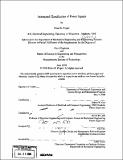| dc.contributor.advisor | Robert W. Cox and Steven B. Leeb. | en_US |
| dc.contributor.author | Proper, Ethan R. (Ethan Richard) | en_US |
| dc.contributor.other | System Design and Management Program. | en_US |
| dc.date.accessioned | 2009-03-16T19:49:55Z | |
| dc.date.available | 2009-03-16T19:49:55Z | |
| dc.date.copyright | 2008 | en_US |
| dc.date.issued | 2008 | en_US |
| dc.identifier.uri | http://hdl.handle.net/1721.1/44842 | |
| dc.description | Thesis (Nav. E.)--Massachusetts Institute of Technology, Dept. of Mechanical Engineering; and, (S.M.)--Massachusetts Institute of Technology, System Design and Management Program, 2008. | en_US |
| dc.description | Includes bibliographical references (p. 106-107). | en_US |
| dc.description.abstract | The Non-Intrusive Load Monitor (NILM) is a device that utilizes voltage and current measurements to monitor an entire system from a single reference point. The NILM and associated software convert the V/I signal to spectral power envelopes that can be searched to determine when a transient occurs. The identification of this signal can then be determined by an expert classifier and a series of these classifications can be used to diagnose system failures or improper operation. Current NILM research conducted at Massachusetts Institute of Technology's Laboratory for Electromagnetic and Electronic Systems (LEES) is exploring the application and expansion of NILM technology for the use of monitoring shipboard systems. This thesis presents the ginzu application that implements a detect-classify-verify loop that locates the indexes of transients, identifies them using a decision-tree based expert classifier, and then generates a summary event file containing relevant information. The ginzu application provides a command-line interface between streaming preprocessed power data (PREP) and an included graphical user interface. This software was developed using thousands of hours of archived data from the Coast Guard Cutters ESCANABA (WMEC-907) and SENECA (WMEC-906). A validation of software effectiveness was conducted as the software was installed onboard ESCANABA. | en_US |
| dc.description.statementofresponsibility | by Ethan R. Proper. | en_US |
| dc.format.extent | 177 p. | en_US |
| dc.language.iso | eng | en_US |
| dc.publisher | Massachusetts Institute of Technology | en_US |
| dc.rights | M.I.T. theses are protected by
copyright. They may be viewed from this source for any purpose, but
reproduction or distribution in any format is prohibited without written
permission. See provided URL for inquiries about permission. | en_US |
| dc.rights.uri | http://dspace.mit.edu/handle/1721.1/7582 | en_US |
| dc.subject | Mechanical Engineering. | en_US |
| dc.subject | System Design and Management Program. | en_US |
| dc.title | Automated classification of power signals | en_US |
| dc.type | Thesis | en_US |
| dc.description.degree | S.M. | en_US |
| dc.description.degree | Nav.E. | en_US |
| dc.contributor.department | Massachusetts Institute of Technology. Department of Mechanical Engineering | en_US |
| dc.identifier.oclc | 301591649 | en_US |
